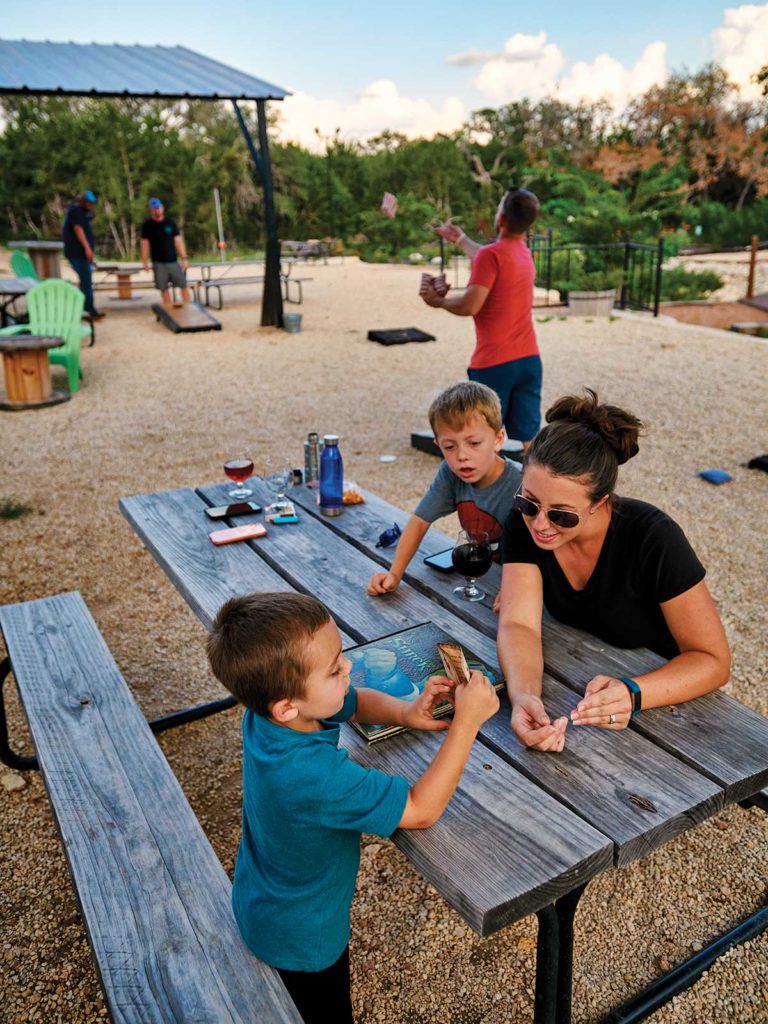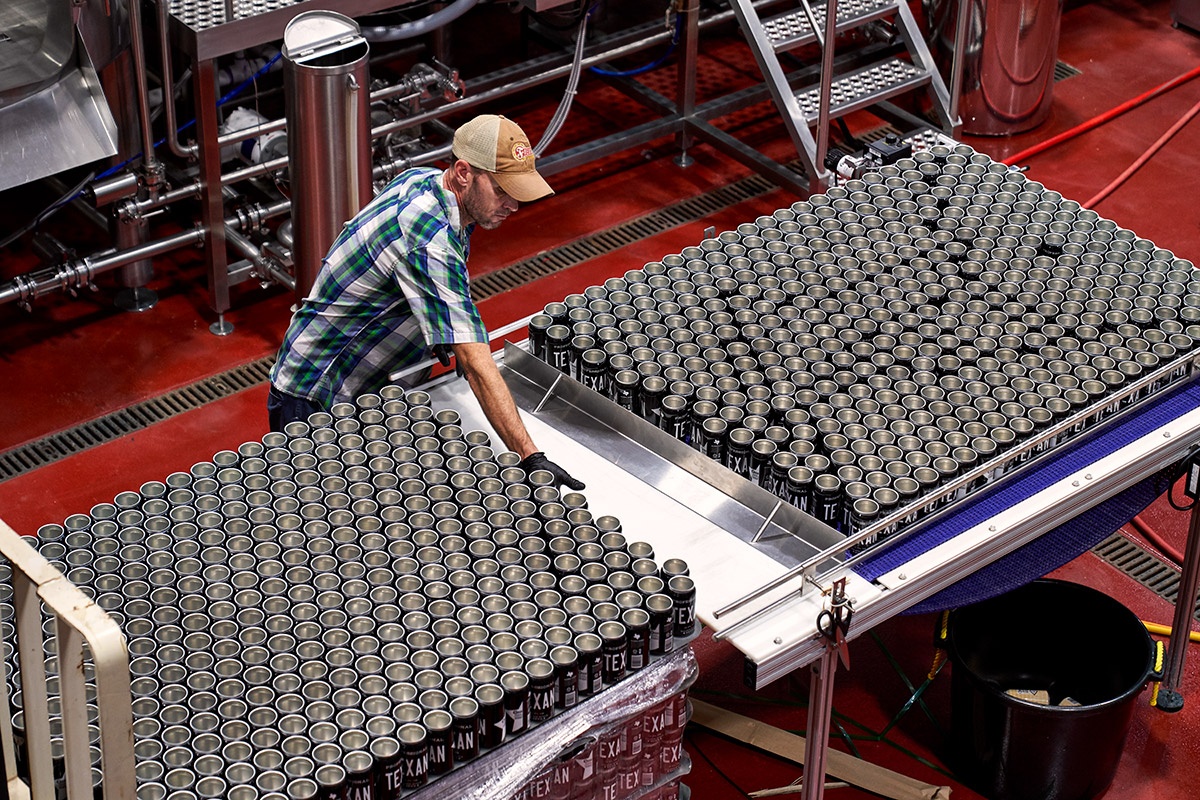On a sunny fall afternoon, large overhead fans supplement a light breeze blowing through open doors. Several couples perch at a long bar, dogs sprawled on the concrete floor nearby. People group around tables, deep into spirited board games. Out the back door, others dig into plates of barbecue at shaded picnic tables.
Bandera Ale Project is one of a new breed of community gathering spots. All around Texas, craft breweries have become destinations where folks bring the family and the dog, and play games or listen to music or comedy acts. The adults taste new flavors and types of beers, observe the brewing process and even meet the brewmaster.

After a day of preparing their hunting camp, Jezire and Brent Akin treat themselves to Bandera Ale Project beers.
Dave Shafer

Bandera Ale Project’s beer garden.
Dave Shafer

John Oliver, brewmaster at Bandera Ale Project.
Dave Shafer
Nearly 300 craft breweries now operate in Texas, representing a $5.3 billion slice of the state’s economy. Texas produces more craft beer than all but seven other states but ranks 46th in breweries per capita.
Josh Hare of Hops & Grain Brewing in Austin and chairman of the Texas Craft Brewers Guild board says several challenges have hampered the Texas industry. “When we opened Hops & Grain in 2011, it was not legal to operate a tasting room,” he says. “The beer you poured had to be free.” Brewers got around that by selling the glasses into which they poured beer. Then legislation passed in 2013 allowed brewers to sell beer on-site.
“From 2013 forward, we went from a dozen or so breweries to more than 70 just in Austin,” Hare says.
The 2019 Legislature allowed manufacturing breweries to sell beer to go. Before that, Texas had been the only state that prohibited sales of six-packs or growlers (reusable bottles) for customers to take home. Other limits remain, though, including how much product a brewery can distribute, Hare explains.
The Texas brewing industry comprises three tiers —manufacturing, distribution and retail—with specific rules for each. A manufacturing brewery that produces fewer than 225,000 barrels annually can operate a tasting room and sell on-site only. A brewpub, considered retail, can make and sell beer for consumption on-site or off-site but only up to 10,000 barrels per year. Hops & Grain is about to reach that size, Hare says. “Do we give up the ability to sell beer to go in order to make more?”
Meanwhile, beer tourism has grown across the state, Hare points out, and that growth means more manufacturing jobs. “This is a manufacturing industry that employs a lot of folks,” he says. “The retail components of craft breweries, from live entertainment to food trucks and tour groups, create additional jobs.”
Bandera Ale Project, a member of Bandera Electric Cooperative, stages music every Saturday and prefers to hire local artists, says co-owner and brewmaster John Oliver. “We have music, comedy, open mic, karaoke. And we’re family friendly,” he says. “We cultivate that atmosphere; we’re not your typical bar.”
The brewery, about 50 miles northwest of San Antonio, offers free Wi-Fi, too, using Bandera EC’s high-speed fiber internet. Communication specialist Samantha Gleason says BEC Fiber launched about the time the brewery opened. “Bandera Brewery added more of a community space to the area,” she says. “And they contribute to support of local businesses, instead of buying from a bar that gets its product from outside the community.”
Some craft breweries also play a role in revitalization efforts by restoring old, abandoned buildings. In downtown Lockhart, Caracara Brewing Company occupies a formerly empty historic building. In the North Texas town of Nocona, Nocona Beer & Brewery took over a former boot factory.

The old Nocona Boots factory is now home to Nocona Beer & Brewery.
Dave Shafer

Dave Young, Nocona’s head brewer, keeps a watchful eye on his 6,100-gallon tanks.
Dave Shafer

What once was the factory for the famous Nocona Boot Company now houses Nocona Beer & Brewery.
Dave Shafer

Jody Jones serves conviviality by the pint at Nocona.
Dave Shafer
Craft brewing could bring jobs to the agriculture industry in Texas as well. Four basic ingredients go into making beer: hops, barley, water and yeast. Craft brewers use more hops than mass-produced beers, according to Neil Reid, the “beer professor” at the University of Toledo. For example, an imperial India pale ale style of beer uses 4 pounds of hops per keg, while a traditional pilsner uses less than half a pound. Small brewers also use hops to create unique flavors, while mass-produced beers focus on hop varieties that provide consistency of taste.
Even though most barley comes from outside Texas, Quentin Hart of the National Agricultural Statistics Service says that between 2012 and 2017, the number of acres of barley harvested in Texas increased nearly 93%.
Barley used in beer is malted, which involves steeping the grain in water under controlled conditions, allowing it to sprout, then drying it.
Cory Artho is co-owner of Maverick Malt House, 20 miles west of Amarillo, one of several malting houses operating in the state. Price is his biggest challenge. Malt from Canada, which produces millions of tons, sells for 40 or 50 cents a pound. “We have a 5-ton machine, and if we ran it year-round, we might make 400,000 pounds,” he says. That smaller volume means Maverick must charge 80 cents a pound.
Still, the idea of local ingredients appeals to Texas brewers. Southerleigh Fine Food and Brewery in San Antonio makes the only all-Texas beer, Artho says. Texas Born and Bred, a pale ale, contains his barley, hops from Hank’s Hops in San Antonio, which grows the flowers hydroponically in a greenhouse, and yeast from Texas Yeast Lab in New Braunfels.

Cans await beer at Fredonia Brewery in Nacogdoches.
Dave Shafer

Fredonia Brewery partner Paul Murray prepares thousands of cans waiting to be filled with the popular Professional Texan Kölsch beer.
Dave Shafer

Thursday is team trivia night at Fredonia Brewery. That means lots of beer, on-site brisket and stiff competition based on knowledge of Star Wars characters.
Dave Shafer
Beyond hops and barley, going local becomes easier. Oliver says that for its honey brown ale, Bandera Ale Project uses Doyle’s Honey, produced by Kent Doyle, a member of Medina Electric Cooperative. Its coffee porter uses coffee beans from Texas.
Jim and Carly Baroffio opened the Bandera brewery in November 2017, and Oliver joined shortly thereafter. “This location was the perfect place to put a brewery because we had access to the property behind for a beer garden,” Oliver says. “You couldn’t find a property big enough for the garden in San Antonio or even on Main Street in Bandera.”
Bandera Ale Project offers barbecue from Busbee’s Bar-B-Que on Main Street. “We wanted someone from Bandera, to make it like a small second location,” Oliver says. “They cook all the food at the main location and bring it here.”
All the fun aside, craft brewing is, bottom line, about the beer. Texas beers snapped up 29—including 11 gold—of the more than 400 medals awarded at the 2019 U.S. Open Beer Championship, where Fredericksburg’s Altstadt Brewery ranked as one of the top 10 breweries overall.
Bandera Ale Project attended its first competition, the Great American Beer Festival, in Denver in October. “Back when we started, we had just two beers on tap, a blonde ale and a honey brown ale, and sometimes we ran out of one because we only had one fermenter,” Oliver says. “After a few months, we got two more fermenters and had four beers on tap, then eight. We bought two more and now have 14 beers on tap. It’s been a learning process. People still come by just for those first two beers, though.”
That hard work has made beer a good reason for people to visit craft brewing establishments across the state. But certainly not the only one.


